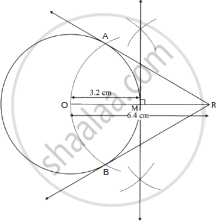Advertisements
Advertisements
Question
Draw a circle of diameter 6.4 cm. Take a point R at a distance equal to its diameter from the centre. Draw tangents from point R.
Solution
Steps of Construction:
Step 1: Construct a circle of radius = \[\frac{6 . 4}{2}\] = 3.2 cm with centre O.
Step 2: Take a point R in the exterior of the circle such that OR = 6.4 cm.
Step 3: Draw segment OR. Draw the perpendicular bisector of segment OR to get its midpoint M.
Step 4: Draw a circle with radius OM and centre M.
Step 5: Name the point of intersection of the two circles as A and B.
Step 6: Draw line RA and line RB.

Here, line RA and line RB are tangents to the circle from point R.
APPEARS IN
RELATED QUESTIONS
Draw the tangents to the circle from the point L with radius 2.7 cm. Point ‘L’ is at a distance 6.9 cm from the centre ‘M’.
Draw tangents to the circle with center ‘C’ and radius 3.6 cm, from a point B at a distance of 7.2 cm from the center of the circle.
Construct tangents to the circle from the point B, having radius 3.2 cm and centre 'C'. Point B is at a distance 7.6 cm from the centre.
Draw a circle with centre P and radius 3.4 cm. Take point Q at a distance 5.5 cm from the centre. Construct tangents to the circle from point Q.
Draw a circle with radius 4.1 cm. Construct tangents to the circle from a point at a distance 7.3 cm from the centre.
Draw a circle of radius 3.4 cm and centre E. Take a point F on the circle. Take another point A such that E-F-A and FA = 4.1 cm. Draw tangents to the circle from point A.
Draw a circle with centre P and radius 2.1 cm. Take point Q at a distance 5.2 cm from the centre. Draw tangents to the circle from point Q. Measure and write the length of a tangent segment.
Draw the tangents to the circle from the point L with radius 3 cm. Point ‘L’ is at a distance 8 cm from the centre ‘M’.
Construct tangents to the circle from the point B, having radius 3.2 cm and centre 'C'. Point B is at a distance 7.2 cm from the centre.
Draw a circle with radius 4.1 cm. Construct tangents to the circle from a point at a distance 7.3 cm from the centre.
Draw a circle with a radius of 3.3 cm. Draw a chord PQ of length 6.6 cm. Draw tangents to the circle at points P and Q. Write your observation about the tangents.
Draw a circle with radius 4 cm and construct two tangents to a circle such that when those two tangents intersect each other outside the circle they make an angle of 60° with each other
Draw a circle with center O and radius 3 cm. Take point P outside the circle such that d (O, P) = 4.5 cm. Draw tangents to the circle from point P.
Draw a circle with radius 4.1 cm. Construct tangents to the circle from a point at a distance 7.3 cm from the centre.
Given: O is the centre of the circle, AB is a diameter, OA = AP, O – A – P, PC is a tangent through C. A tangent through point A intersects PC in E and BC in D.
To prove: ΔCED is an equilateral triangle.
